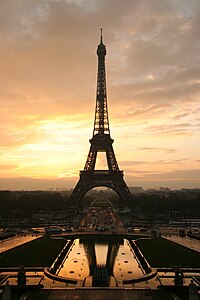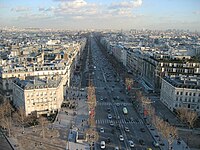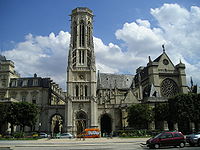
Paris' Eiffel tower
France. It is situated on the River Seine, in northern France, at the heart of the Île-de-Franceregion ("Région parisienne"). The city of Paris has an estimated population of 2,153,600 within city limit (2005 est.).[2] The Paris urban area has a population of 9.93 million [3] and a commuter belt around the same completes the Paris "aire urbaine" (roughly: "metropolitan area") that, with its population of 11.5 million,[4] is one of the most populated areas of its kind in Europe.[5]
Paris' location at a crossroads between land and river trade routes in lands of abundant agriculture had made it one of France's principal cities by the 10th century, rich with royal palaces, wealthy abbeys and a cathedral; by the 12th century Paris had become one of Europe's foremost centres of learning and the arts. Today, Paris is a major influence in politics, fashion, business, arts and science. The city serves as an important hub of intercontinental transportation and is home to universities, sport events, opera companies and museums of international renown,[6][7] making it an attraction for over 30 million foreign visitors per year.[8]
The Paris region (Île-de-France) is France's foremost centre of economic activity. With €478.7 billion (US$595.3 billion), it produced more than a quarter of the gross domestic product (GDP) of France in 2005. With La Défense, the largest purpose-built business district in Europe, it hosts the head offices of almost half of the major French companies, as well as the headquarters of ten of the world's 100 largest companies.[9] Paris also hosts many international organizations such as UNESCO, the OECD, the ICC, or the informal Paris Club. It is regarded as one of the world's 4 major global cities.[10]
Districts and historical centres
These are a few of Paris' major districts.





- Champs-Élysées (8th arrondissement, right bank) is a seventeenth century garden-promenade turned avenue connecting the Concorde and Arc de Triomphe. It is one of the many tourist attractions and a major shopping street of Paris. This avenue has been called "la plus belle avenue du monde" ("the most beautiful avenue in the world").
- Avenue Montaigne (8th arrondissement), next to the Champs-Élysées, is home to luxury brand labels such as Chanel, Louis Vuitton (LVMH), Dior and Givenchy.
- Place de la Concorde (8th arrondissement, right bank) is at the foot of the Champs-Élysées, built as the "Place Louis XV", site of the infamous guillotine. The Egyptian obelisk is Paris's "oldest monument". On this place, on the two side of the Rue Royale live two identical stone buildings: the eastern houses the French Naval Ministry, the western the luxurious Hôtel de Crillon. Nearby Place Vendome is famous for its fashionable and deluxe hotels (Hotel Ritz and Hôtel de Vendôme) and its jewellers. Many famous fashion designers have had their salons in the square.
- Faubourg Saint-Honoré (8th arrondissement, right bank) is one of Paris' high-fashion districts, home to labels such as Hermès and Christian Lacroix.
- L'Opéra (9th arrondissement, right bank) is the area around the Opéra Garnier is a home to the capital's densest concentration of both department stores and offices. A few examples are the Printemps and Galeries Lafayette grands magasins (department stores), and the Paris headquarters of financial giants such as Crédit Lyonnais and American Express.
- Montmartre (18th arrondissement, right bank) is a historic area on the Butte, home to the Basilica of the Sacré Coeur. Montmartre has always had a history with artists and has many studios and cafés of many great artists in that area.
- Les Halles (1st arrondissement, right bank) was formerly Paris' central meat and produce market, since the late 1970s a major shopping center around an important metro connection station (the biggest in Europe). The past Les Halles was destroyed in 1971 and replaced by the Forum des Halles. The central market of Paris, the biggest wholesale food market in the world, was transferred to Rungis, in the southern suburbs.
- Le Marais (3rd and 4th arrondissements) is a trendy Right Bank district. With large gay and Jewish populations it is a very culturally open place.
- Place de la Bastille (4th, 11th and 12th arrondissements, right bank) being one of the most historic districts, being a location of an essential event of not only Paris, but the whole country of France. Because of its historical value the square is often used for political demonstrations, including the massive anti-CPE demonstration of March 28, 2006.
- Quartier Latin (5th and 6th arrondissements, left bank) is a twelfth century scholastic centre formerly stretching between the Left Bank's Place Maubert and the Sorbonne campus. It is known for its lively atmosphere and many bistros. With various higher education establishments, such as the École Normale Supérieure, ParisTech and the Jussieu university campus make it a major educational center in Paris, which also contributes to its atmosphere.
- Montparnasse (14th arrondissement) is a historic Left Bank area famous for artists studios, music halls, and café life. The large Montparnasse - Bienvenüe métro station and the lone Tour Montparnasse skyscraper are located there.
- La Défense (straddling the communes of Courbevoie, Puteaux, and Nanterre, 2.5 km/1.5 miles west of the City of Paris) is a key suburb of Paris and is one of the largest business centres in the world. Built at the western end of a westward extension of Paris' historical axis from the Champs-Élysées, La Défense consists mainly of business highrises. Initiated by the French government in 1958, the district hosts 3.5 million m² of offices, making of it the largest district in Europe specifically developed for business. The Grande Arche (Great Arch) of la Defense, which houses a part of the French Transports Minister's headquarters, ends the central Esplanade around which the district is organized.
Monuments and landmarks

Three of the most famous Parisian landmarks are the twelfth century cathedral Notre Dame de Paris on the Île de la Cité, the nineteenth century Eiffel Tower, and the Napoleonic Arc de Triomphe. The Eiffel Tower was a "temporary" construction by Gustave Eiffel for the 1889 Universal Exposition but the tower was never dismantled and is now an enduring symbol of Paris. It is visible from many parts of the city as are the Tour Montparnasse skyscraper and the Basilica of the Sacré Cœur on the Montmartre hill.
The Historical axis is a line of monuments, buildings and thoroughfares that run in a roughly straight line from the city centre westwards: the line of monuments begins with the Louvre and continues through the Tuileries Gardens, the Champs-Élysées and the Arc de Triomphe centred in the Place de l'Étoile circus. From the 1960s the line was prolonged even further west to the La Défense business district dominated by square-shaped triumphal Grande Arche of its own; this district hosts most of the tallest skyscrapers in the Paris urban area.


The Invalides museum is the burial place for many great French soldiers, including Napoleon, and the Panthéon church is where many of France's illustrious men and women are buried. The former Conciergerie prison held some prominent ancien régime members before their deaths during the French Revolution. Another symbol of the Revolution are the two Statues of Liberty located on the Île des Cygnes on the Seine and in the Luxembourg Garden. A larger version of the statues was sent as a gift from France to the United States in 1886 and now stands in New York City harbour.
The Palais Garnier built in the later Second Empire period, houses the Paris Opera and the Paris Opera Ballet, while the former palace of the Louvre now houses one of the most famous museums in the world. The Sorbonne is the most famous part of the University of Paris and is based in the centre of the Latin Quarter. Apart from Notre Dame de Paris, there are several other ecclesiastical masterpieces including the Gothic thirteenth century Sainte-Chapelle palace chapel and the Église de la Madeleine.
[edit] Parks and gardens

Two of Paris's oldest and famous gardens are the Tuileries Garden, created from the 16th century for a palace on the banks of the Seine near the Louvre, and the Left bank Luxembourg Garden, another formerly private garden belonging to a château built for the Marie de' Medici in 1612. The Jardin des Plantes, created by Louis XIII's doctor Guy de La Brosse for the cultivation of medicinal plants, was Paris' first public garden.

architect Barillet-Deschamps
A few of Paris' other large gardens are Second Empire creations: the formerly suburban parks of Montsouris, Buttes Chaumont and Parc Monceau (formerly known as the "folie de Chartres"), were creations of Napoleon III's engineer Jean-Charles Alphand and the landscape . You will often see Parisians having picnics at the parks, soaking up the warm sunshine, or simply enjoying the nature. They are peaceful escapes from the city and are enjoyed by all ages. Another project executed under the orders of Baron Haussmann was the re-sculpting of Paris' western Bois de Boulogne forest-parklands; the Bois de Vincennes, to Paris' opposite eastern end, received a similar treatment in years following.
Newer additions to Paris' park landscape are the Parc de la Villette, built by the architect Bernard Tschumi on the location of Paris' former slaughterhouses, and gardens being lain to Paris' periphery along the traces of its former circular "Petite Ceinture" railway line.

Paris' cemeteries were on its outskirts upon their 1804 creation. Many of Paris' churches had their own cemeteries, but, by the late 18th century, they were making living conditions unpleasant for nearby housing. Abolished from 1786, all parish cemeteries contents were taken to abandoned limestone mines outside the southern gates of then Paris, today the 14e arrondissement's place Denfert-Rochereau. The latter are known today as the Paris Catacombes.
Although Paris today has once again grown to surround all its former cemeteries, these have become much-appreciated oases of quiet in a thriving city. Many of Paris's historical figures have found rest in Père Lachaise Cemetery. Other notable cemeteries include Cimetière de Montmartre, Cimetière du Montparnasse, Cimetière de Passy and the Catacombs of Paris.
New suburban cemeteries were created in the early 20th century: the largest of these are the Cimetière Parisien de Saint-Ouen, the Cimetière Parisien de Bobigny-Pantin, the Cimetière Parisien d'Ivry and the Cimetière Parisien de Bagneux.







No comments:
Post a Comment